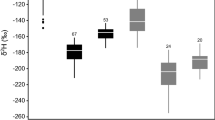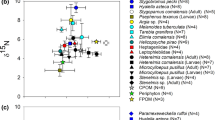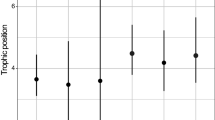Abstract
Stable isotopes (13C and 15N) are widely applied in studies of trophic links. We used this method to investigate the contribution of aquatic and terrestrial prey to the diet of riparian predatory arthropods in two mountain headwater streams in Colorado, USA. Aquatic and terrestrial prey and riparian predators were collected during summer 2009. To evaluate the reliability of conclusions based on stable isotope ratios, we compared the isotopic signatures of aquatic larval and terrestrial adult stages of three abundant stream insect species and assessed variation in mixing model estimates for spider diet composition under varying assumptions for trophic fractionation. Adult isotopic signatures of some aquatic prey species were indistinguishable from those of prey species with exclusively terrestrial life histories (stoneflies: 13C and 15N, chironomids: 13C). Other prey had distinctly aquatic isotopic signatures as both larvae and adults (a mayfly and a caddisfly). There was no evidence that prey with aquatic isotopic signatures contributed to the diet of the spiders near one stream. For the other stream, mixing model analysis suggested that chironomids were included in the diets of lycosid, linyphiid and liocranid spiders. Reliable estimates of the contributions of prey sources were compromised by the sensitivity of mixing models to assumptions on trophic fractionation and the presence of “isotopically cryptic” prey. This study emphasizes the importance of supporting isotope-based studies on cross-boundary trophic links with data on isotopic shifts in prey with complex life cycles and assessment of fractionation rates specific to the study system.




Similar content being viewed by others
References
Barnes C, Sweeting CJ, Jennings S, Barry JT, Polunin NVC (2007) Effect of temperature and ration size on carbon and nitrogen stable isotope trophic fractionation. Funct Ecol 21:356–362
Baumann RW, Gaufin AR, Surdick RF (1977) The stoneflies (Plecoptera) of the Rocky Mountains. Mem Amer Entomol Soc 31:1–208
Baxter CV, Fausch KD, Saunders WC (2005) Tangled webs: reciprocal flows of invertebrate prey link streams and riparian zones. Freshw Biol 50:201–220
Brittain JE (1982) Biology of mayflies. Ann Rev Entomol 27:119–147
Burtt ET, Perry RJO, McLachlan AJ (1986) Feeding and sexual dimorphism in adult midges (Diptera: Chironomidae). Holarct Ecol 9:27–32
Cabana G, Rasmussen JB (1996) Comparison of aquatic food chains using nitrogen isotopes. Proc Nat Acad Sci 93:10844–10847
Chan EKW, Zhang Y, Dudgeon D (2009) Substrate availability may be more important than aquatic insect abundance in the distribution of riparian orb-web spiders in the tropics. Biotropica 41:196–201
Collier KJ, Bury S, Gibbs M (2002) A stable isotope study of linkages between stream and terrestrial food webs through spider predation. Freshw Biol 47:1651–1659
De Figueroa JMT, Sánchez-Ortega A (2000) Imaginal feeding of twelve nemouroidean stonefly species (Insecta, Plecoptera). Ann Entomol Soc Am 93:251–253
Finlay JC (2001) Stable-carbon-isotope ratios of river biota: implications for energy flow in lotic food webs. Ecology 82:1052–1064
Gamboa M, Kimbirauskas RK, Merritt RW, Monaghan MT (2012) A molecular approach to identifying the natural prey of the african cree** water bug Naucoris, a potential reservoir of Mycobacterium ulcerans. J Insect Sci 12:1–10
Gannes LZ, O’Brien DM, Martinez del Rio C (1997) Stable isotopes in animal ecology: assumptions, caveats, and a call for more laboratory experiments. Ecology 78:1271–1276
Gratton C, Donaldson J, Vander Zanden MJ (2008) Ecosystem linkages between lakes and the surrounding terrestrial landscape in Northeast Iceland. Ecosystems 11:764–774
Greenstone MH, Shufran KA (2003) Spider predation: species-specific identification of gut contents by polymerase chain reaction. J Arachnology 31:131–134
Hering D, Plachter H (1997) Riparian ground beetles (Coeloptera, Carabidae) preying on aquatic invertebrates: a feeding strategy in alpine floodplains. Oecologia 111:261–270
Hynes HBN (1942) A study of the feeding of adult stoneflies (Plecoptera). Proc R Entomol Soc London Ser A 17:7–9
Hynes HBN (1970) The ecology of running waters. Liverpool University Press, Liverpool
Jackson JK, Fisher SG (1986) Secondary production, emergence, and export of aquatic insects of a Sonoran desert stream. Ecology 67:629–638
Kato C, Iwata T, Wada E (2004) Prey use by web-building spiders: stable isotope analyses of trophic flow at a forest-stream ecotone. Ecol Res 19:633–643
Kovats ZE, Ciborowski JJH, Corkum LD (1996) Inland dispersal of adult aquatic insects. Freshw Biol 36:265–276
McCutchan JHJ, Lewis WMJ, Kendall C, McGrath CC (2003) Variation in trophic shift for stable isotope ratios of carbon, nitrogen, and sulfur. Oikos 102:378–390
Merritt RW, Cummins KW, Berg MB (2008) An Introduction to the Aquatic Insects of North America. Kendall/Hunt Publishing Company, Dubuque
Minagawa M, Wada E (1984) Stepwise enrichment of 15N along food chains: further evidence and the relation between δ15N and animal age. Geochim Cosmochim Acta 48(5):1135–1140
Murakami M, Nakano S (2002) Indirect effect of aquatic insect emergence on a terrestrial insect population through by birds predation. Ecol Lett 5:333–337
Nakano S, Murakami M (2001) Reciprocal subsidies: dynamic interdependence between terrestrial and aquatic food webs. Proc Nat Acad Sci 98:166–170
Nakano S, Miyasaka H, Kuhara N (1999) Terrestrial-aquatic linkages: riparian arthropod inputs alter trophic cascades in a stream food web. Ecology 80:2435–2441
Nentwig W (1980) The selective prey of linyphiid-like spiders and of their space webs. Oecologia 45:236–243
Nentwig W (1982) Epigeic spiders, their potential prey and competitors: relationship between size and frequency. Oecologia 55:130–136
Ostrom PH, Colunga-Garcia M, Gage SH (1997) Establishing pathways of energy flow for insect predators using stable isotope ratios: field and laboratory evidence. Oecologia 109:108–113
Paetzold A, Tockner K (2005) Effects of riparian arthropod predation on the biomass and abundance of aquatic insect emergence. J N Am Benthol Soc 24:395–402
Paetzold A, Schubert CJ, Tockner K (2005) Aquatic terrestrial linkages along a braided-river: riparian arthropods feeding on aquatic insects. Ecosystems 8:748–759
Paetzold A, Bernet JF, Tockner K (2006) Consumer-specific responses to riverine subsidy pulses in a riparian arthropod assemblage. Freshw Biol 51:1103–1115
Paetzold A, Lee M, Post D (2008) Marine resource flows to terrestrial arthropod predators on a temperate island: the role of subsidies between systems of similar productivity. Oecologia 157:653–659
Parnell AC, Inger R, Bearhop S, Jackson AL (2010) Source partitioning using stable isotopes: co** with too much variation. PLoS ONE 5:e9672
Peckarsky BL, Dodson SI, Conklin DJ (1985) A key to the aquatic insects of streams in the vicinity of the Rocky Mountain Biological Lab including chironomid larvae from streams and ponds. Colorado Division of Wildlife, Colorado
Peckarsky BL, Taylor BW, Caudill CC (2000) Hydrologic and behavioral constraints on oviposition in stream insects: implications for adult dispersal. Oecologia 125:186–200
Peckarsky BL, McIntosh A, Caudill CC, Dahl J (2002) Swarming and mating behavior of a mayfly Baetis bicaudatus suggest stabilizing selection for male body size. Behav Ecol Sociobiol 51:530–537
Petersson E, Hasselrot AT (1994) Mating and nectar feeding in the psychomyiid caddisfly Tinodes waeneri. Aquat Insects 16:177–187
Pinder LCV (1986) Biology of freshwater Chironomidae. Annu Rev Entomol 31:1–23
Polis GA, Anderson WB, Holt RD (1997) Toward an integration of landscape and food web ecology: the dynamics of spatially subsidized food webs. Annu Rev Ecol Syst 28:289–316
Post DM (2002) Using stable isotopes to estimate trophic position: models, methods, and asssumptions. Ecology 83:703–718
Power ME, Rainey WE, Parker MS, Sabo JL, Smyth A, Khandwala S et al (2004) River-to-watershed subsidies in an old-growth conifer forest. In: Polis GA, Power ME, Huxel GR (eds) Food webs at landscape level. University of Chicago Press, Chicago, pp 217–240
R Core Team (2012) R: A language and environment for statistical computing. R Foundation for Statistical Computing, Vienna, Austria. ISBN 3-900051-07-0. http://www.R-project.org/
Sabo JL, Power ME (2002) Numerical response of lizards to aquatic insects and short-term consequences for terrestrial prey. Ecology 83:3023–3036
Sanzone DM, Meyer JL, Marti E, Gardiner EP, Tank JL, Grimm NB (2003) Carbon and nitrogen transfer from a desert stream to riparian predators. Oecologia 134:238–250
Schlee D (1977) Florale und extraflorale Nektarien sowie Insektenkot als Nahrungsquelle für Chironomidae Imagines (und andere Diptera). Stuttg Beitr Naturk Ser A 300:1–15
Sepulveda AJ, Lowe AJ, Marra PP (2012) Using stable isotopes to test for trophic niche partitioning: a case study with stream salamanders and fish. Freshw Biol 57:1399–1409
Sulzman EW (2007) Stable isotope chemistry and measurement: a primer. In: Michener R, Lajtna K (eds) Stable isotopes in ecology and environmental science, 2nd edn. Blackwell Publishing, Oxford, pp 1–21
Ubick D, Paquin P, Cushing PE, Roth V (2005) Spiders on North America: an identification manual. American Arachnological Society, Keene (New Hampshire)
Vander Zanden JM, Rasmussen JB (1999) Primary consumer delta 13C and delta 15N and the trophic position of aquatic consumers. Ecology 80:1395–1404
Wallace JB, Eggert SL, Meyer JL, Webster JR (1997) Multiple trophic levels of a forest stream linked to terrestrial litter inputs. Science 277:102–104
Walters DM, Fritz KM, Otter RR (2008) The dark side of subsidies: adult stream insects export organic contaminants to riparian predators. Ecol Appl 18:1835–1841
Winterbourn MJ (2005) Dispersal feeding and parasitism of adult stoneflies (Plecoptera) at a New Zealand forest stream. Aquat Insects 27:155–166
Wise DH (1993) Spiders in ecological webs. Cambridge University Press, Cambridge
Wise DH, Moldendhauer DM, Halaj J (2006) Using stable isotopes to reveal shifts in prey consumption by generalist predators. Ecol Appl 16:865–876
Acknowledgments
We thank Wendy Brown for assistance in the field and laboratory and particularly for spider identification, Steve Horn, Maruxa Alvarez, Angus McIntosh, Marge Penton and Carrie Robbins for help in the field and fruitful discussions on the project, Jen Moslemi for kindly providing her isotope data, Billy Barr and the Rocky Mountain Biological Laboratory for providing support and facilities for this study, anonymous reviewers whose comments helped to improve the manuscript from earlier versions and Jake Vander Zanden and Erika Nilsson for valuable advice when planning the study. This project was partially funded by an Eawag Mobility Grant to M. Alp, the Swiss Federal Department of the Environment, and National Science Foundation Grant no. DEB—0516035 awarded to B.L. Peckarsky. IGB Fellowship in Freshwater Science supported Maria Alp during preparation of this manuscript.
Author information
Authors and Affiliations
Corresponding author
Electronic supplementary material
Below is the link to the electronic supplementary material.
Electronic Supplemental Information Online Source 1 includes supplementary tables with sampling site description, pitfall composition and all measured isotopic values.
Rights and permissions
About this article
Cite this article
Alp, M., Peckarsky, B.L., Bernasconi, S.M. et al. Shifts in isotopic signatures of animals with complex life-cycles can complicate conclusions on cross-boundary trophic links. Aquat Sci 75, 595–606 (2013). https://doi.org/10.1007/s00027-013-0303-x
Received:
Accepted:
Published:
Issue Date:
DOI: https://doi.org/10.1007/s00027-013-0303-x




